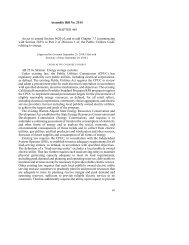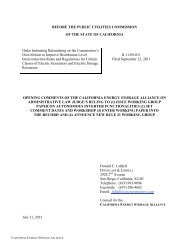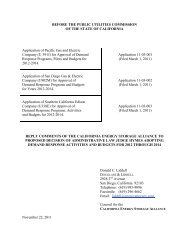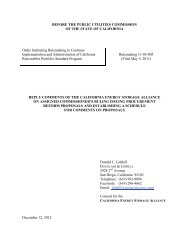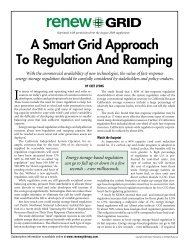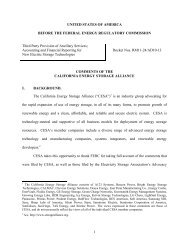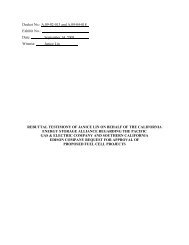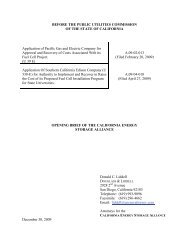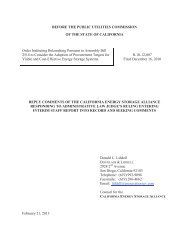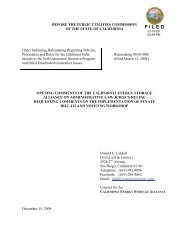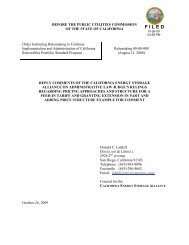04-05-13 CESA's Flexible RA Comments - California Energy ...
04-05-13 CESA's Flexible RA Comments - California Energy ...
04-05-13 CESA's Flexible RA Comments - California Energy ...
You also want an ePaper? Increase the reach of your titles
YUMPU automatically turns print PDFs into web optimized ePapers that Google loves.
Before the end of 20<strong>13</strong>the Commission should adopt a category of flexible <strong>RA</strong> capacity,in collaboration with the CAISO, that specifically takes into full consideration all of the flexiblecapabilities of energy storage resources. This should allow energy storage resources to provideadditional energy-related products and ancillary services from standalone energy storage systemsas well as energy storage resources integrated with both preferred resources and fossil generatingresources . 7As discussed below, CESA also continues to advocate for adoption of a multi-yearcontracting mechanism for procurement of flexible <strong>RA</strong> capacity that includes energy storageresources. 8 CESA likewise advocates in this proceeding, as it has in the Commission’s LongTerm Procurement Planning (“LTPP”) proceeding, for adoption of an NQC value for energystorage resources with less than one-hour capacity by which they can be allocated MWs offlexible <strong>RA</strong> capacity corresponding to their sustained discharge over 15 minute intervals. 9III.THE COMMISSION SHOULD ESTABLISH A RESOURCE ADEQUACYF<strong>RA</strong>MEWORK TO DETERMININE HOW FLEXIBLE PROCUREMENTOBLIGATIONS CAN BE MET BY LOAD SERVING ENTITIES IN FUTURECOMPLIANCE YEARS BEFORE THE END OF 20<strong>13</strong>.The Scoping Memo for Phase 2 of this proceeding directed parties to work towardsdefining “flexibility” for procurement of flexible <strong>RA</strong> capacity, and to develop implementationdetails for incorporating flexible capacity in the 2014 <strong>RA</strong> program. It is apparent that thisimportant policy objective cannot be achieved before June 20<strong>13</strong>, but the Commission should7 <strong>Energy</strong> storage is capable of providing energy, capacity, and ancillary services simultaneously or sequentially, andshould therefore not be arbitrarily limited to providing flexible <strong>RA</strong> capacity to the exclusion of other energy relatedproducts and ancillary services, either expressly or as an unintended consequence of Commission policiesestablished in this and other Commission proceedings. See, <strong>Comments</strong> of the <strong>California</strong> <strong>Energy</strong> Storage Alliance onProposed Decision Adopting Long-Term Procurement Obligations for 20<strong>13</strong> and Further Refining the ResourceAdequacy Program, filed June 11, 2012.8 Id.9 See, Reply <strong>Comments</strong> of the <strong>California</strong> <strong>Energy</strong> Storage Alliance on Administrative Law Judge’s Ruling SeekingComment on Workshop Topics, filed October 23, 2012, in R.12-03-014.4
workshops and comments to explore this rule in the 2014 annual <strong>RA</strong>proceeding and through Phase II of the “<strong>Flexible</strong> Resource Adequacy andMust-Offer Obligation” initiative at the ISO. There is time to develop rulesregarding how use-limited resources can be more economically dispatchedwhile abiding by their use limitations. It is believed that sufficient flexibleresources without use limitations should provide plenty of head room for LSEsto meet their flexible obligations.” (p. 6).Certainly the <strong>Energy</strong> Division staff may be right for 2014, but beyond 2014 the need foradditional flexible resources such as energy storage should be closely evaluated as part of theCommission’s near term efforts to establish an <strong>RA</strong> framework for determining how flexiblecapacity procurement obligations can be met by LSEs.Regrettably, the <strong>Energy</strong> Division and Joint Parties’ <strong>Flexible</strong> <strong>RA</strong> capacity procurementproposals both unreasonably discriminate against participation of preferred resources and energystorage resources. To remedy this fatal policy flaw, the Commission should issue a decision inJune 20<strong>13</strong> that: (a) sets the 2014 <strong>RA</strong> compliance process in motion without any revisions, and(b) determines a scope and schedule through the end of this year to revise the <strong>RA</strong> program todevelop a flexible <strong>RA</strong> capacity procurement program that allows for the full participation ofpreferred resources and energy storage resources.IV.THE COMMISSION SHOULD ADDRESS MULTI-YEAR CONT<strong>RA</strong>CTING FORFLEXIBLE RESOURCE ADEQUACY CAPACITY PROVIDED BY ENERGYSTO<strong>RA</strong>GE BEFORE THE END OF 20<strong>13</strong>.As abundantly evidenced by the recent En Banc hearing held by the Commission and theCAISO, there is now a broad stakeholder consensus that a contracting mechanism for multi-yearfor flexible <strong>RA</strong> capacity must be developed as soon as possible. 11 CESA is on record in this andother Commission proceedings as advocating for multi-year or long-term (i.e., 10 years orgreater) contracting for flexible <strong>RA</strong> capacity provided by energy storage resources.11 Long Term Resource Adequacy Summit, February 26, 20<strong>13</strong>.6
CESA fundamentally agrees with the motion regarding multi-year procurement thatPacific Gas and Electric Company (“PG&E”) filed concurrently in this proceeding and in theLTPP proceeding in September 2012. 12 In its motion, PG&E persuasively argued:“There appears to be an emerging consensus among the parties that participatein the various procurement-related proceedings at the Commission that thecurrent, one year forward resource adequacy program should be improved in atleast two respects. First, it should take into account the need for some level ofresource “flexibility” in order for the system to be operated reliably. . . Second,the current, one-year forward resource adequacy procurement requirementapplicable to all load serving entities should be extended to a multi-yeartimeframe. The Commission has recognized the importance of both issues, andis currently considering both of them. Flexibility is being addressed in thisproceeding, and the multi-year procurement requirement is currently slated tobe addressed in Track 3 of the LTPP. PG&E requests that the two issues beconsidered together, in this [<strong>RA</strong>] proceeding where efforts are alreadyunderway to address flexibility. The two topics are too closely related to beartificially separated.” (pp. 2-3).CESA could just as readily support addressing multi-year procurement in the LTPPproceeding, but the point is that the docket chosen is unimportant, provided that the Commissionconveys a sense of urgency in addressing the subject of multi-year contacting for flexible <strong>RA</strong>capacity to stakeholders.V. THE COMMISSION SHOULD CONSIDER ADOPTING A NET QUALIFYINGCAPACITY VALUE FOR ENERGY STO<strong>RA</strong>GE RESOURCES WITH LESSTHAN ONE-HOUR CAPACITY.<strong>California</strong> Public Utilities Code Section 2836.4(a) (a key provision of AB 2514)provides, “An energy storage system may be used to meet the resource adequacy requirementsestablished for a load-serving entity pursuant to Section 380 if it meets applicable standards.”The “applicable standards referred to in the statute should obviously include NQC. Of course, he12 Motion of Pacific Gas and Electric Company to Move the Multi-Year Procurement Requirement Issue From theLong-Term Procurement proceeding to the Resource Adequacy Proceeding, filed September 20, 2012.7
Commission currently considers energy storage to have an NQC value at least equivalent todemand response (“DR”) resources: <strong>13</strong>“. . . we point out that the existing QC counting methodology 2 differentiatesin general between three classes of resources in setting QC – dispatchableresources, non-dispatchable resources, and wind/solar resources. Storage isnot called out specifically, but depending on whether it was dispatchable ornon-dispatchable, storage would count towards <strong>RA</strong> obligations under theexisting QC methodology.” (p. 23).In its Post-Workshop <strong>Comments</strong> filed in the LTPP proceeding, 14SCE proposed aninterim approach for establishing an NQC value for energy storage: “For purposes ofestablishing NQC values for LCR procurement analysis for energy storage devices (whichcurrently do not have an established NQC), SCE recommends the a set of operating parametersfor energy storage resources as an interim measure. 15 In SCE’s view, applying these criteriawould allow energy storage to be evaluated in local capacity requirement (“LCR”) solicitationscomparable to conventional generation resources.In Reply <strong>Comments</strong>, 16 CESA disagreed with SCE that energy storage with less than onehourof capacity should not have NQC valuation where CESA suggested: “A more appropriateNQC value for energy storage with less than one hour capacity would be to use the capacityformula that the CAISO applies under its Regulation <strong>Energy</strong> Management (“REM”) market forfrequency regulation, in which energy storage resources with less than one hour of capacity are<strong>13</strong> Decision Adopting Local Procurement Obligations for 20<strong>13</strong> and Further Refining the Resource AdequacyProgram, D.12-06-025, issued June 21, 2012.14 <strong>Comments</strong> of Southern <strong>California</strong> Edison on the Joint LTPP/Storage Workshop, held September 7, 2012, filedOctober 5, 2012.15 “<strong>Energy</strong> storage devices with one hour or greater capacity should receive an NQC equal to their maximumsustainable rate of output. For <strong>RA</strong> purposes, qualifying energy devices should be subject to the maximumcumulative capacity buckets, which restrict how much energy-limited capacity can be used to meet <strong>RA</strong>requirements. In order to count for LCR purposes, an energy storage device should have a minimum of three to eighthours of capacity (specific value to be determined in consultation with the CAISO), so it can provide LCR supportfor the peak load of a likely event. <strong>Energy</strong> storage devices with less than one hour of capacity should not have anNQC, since their primary value is in ancillary service markets and/or as frequency response resources.” (SCE<strong>Comments</strong>, pp. 15-16).16 See, footnote number 8, infra.8
allocated MWs of capacity corresponding to their sustained output over 15 minutes” (p. 9).CESA submits that the NQC discussion needs to be part of the Commission’s consideration offlexible <strong>RA</strong> capacity, ramping, and the move from hourly to 15-minute scheduling that is wellunder way at the CAISO and nationally. 17VI.CONCLUSION.CESA appreciates the opportunity to submit these comments on the ALJ’s Ruling, andlooks forward to working with the Commission and stakeholders in Phase 2 of this proceeding.Respectfully submitted,Date: April 5, 20<strong>13</strong>Donald C. LiddellDOUGLASS & LIDDELLCounsel for theCALIFORNIA ENERGY STO<strong>RA</strong>GE ALLIANCE17 The CAISO’s is currently engaged in a stakeholder process devoted to implementation of the Federal <strong>Energy</strong>Regulatory Commission’s Order No. 764 removing intra-hourly transmission scheduling barriers to integration ofvariable energy resources.9



